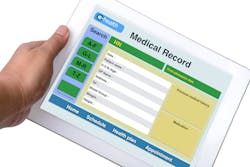While electronic health record (EHR) adoption has increased steadily in U.S. hospitals since 2010, challenges—such as getting small and rural hospitals to adopt the technology—do remain, according to new research published in Health Affairs.
The research team, led by Julia Adler-Milstein, Ph.D., from the University of Michigan, looked at 2008–14 national data, which includes the most recently available, to examine hospital EHR trends. They found large gains in adoption, with 75 percent of U.S. hospitals now having adopted at least a basic EHR system—up from 59 percent in 2013.
However, small and rural hospitals continue to lag behind, the researchers found. Since 2008 there has been more than a 10-percentage-point gap between small and large hospitals in adoption of at least a basic EHR system, according to the research.
Among hospitals without a basic EHR system, the function most often not yet adopted (in 61 percent of hospitals) was physician notes. The researchers also saw large increases in the ability to meet core Stage 2 meaningful use criteria (40.5 percent of hospitals, up from 5.8 percent in 2013); much of this progress resulted from increased ability to meet criteria related to exchange of health information with patients and with other physicians during care transitions, they concluded.
According to the researchers, “While achieving EHR adoption among a majority of hospitals is an important milestone, it is critically important to reach close to nationwide adoption of these systems to gain the network benefits of EHR adoption. However, with the ‘early majority’ having adopted, the remaining hospitals may be those with the biggest challenges and, therefore, least likely to join in. This potential leveling off of adoption, if real, would hinder the goals of a true nationwide health information infrastructure.”
That being said, the findings do suggest that close to 100 percent hospital adoption of basic EHRs is possible in the near future, particularly if hospitals receive help with the transition to physician notes. However, given that physician resistance continues to be cited as a challenge, it will be important to identify ways to ease the conversion to electronic documentation in parallel with other changes required to meet Stage 2 meaningful use criteria, the researchers noted.
What’s more, hospitals have invested a lot of time and energy in the criteria that require health information exchange (HIE): the summary care record for each transition objective (provider-to-provider exchange) as well as the patient’s ability to view, download, and transmit objective (provider-to-patient exchange). However, this is counterbalanced by the finding that the majority of hospitals might not be ready to meet the Stage 2 core objectives when required to do so.
The researchers also said that responding to calls for a Stage 3 delay and continuing to work toward streamlined regulations could free up resources to focus on complementary priorities, such as making the transition from volume- to value-based payment.
The study data came from the American Hospital Association Annual Survey–IT Supplement for information technology adoption for 2008–14, which is sent to the CEO of every U.S. hospital. “Our findings suggest that close to 100 percent hospital adoption of basic EHRs is possible in the near future,” authors concluded. “However, our data reveal specific areas in which hospitals are struggling. Policy strategies that target these issues, which will especially benefit small and rural hospitals, could bring about nationwide hospital EHR adoption.”


